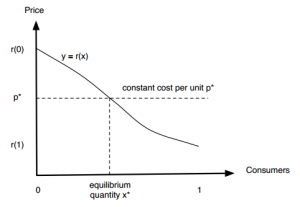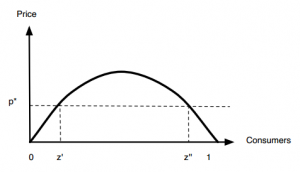Why Apple Kept Using Its 30-Pin Dock Connector for Almost 10 Years – An Aspect of Network Effect
Apple announced its iPhone 5 with a new 9-pin dock connector called Lightening this September. It is the first time Apple made changes to the design and performance of its dock connector. The previous 30-pin dock connector came out in 2003(1), which had been adopted to all its iOS devices like iPod, iPhone and iPad until this September. We all experienced the fast technology development during these years, but we almost forgot the stagnation of the connector. Why Apple kept its unique connector for almost ten years is probably a question we can use benefit of the network effect to explain.
Apple’s unique dock connector strengthened the network effect, which affects people’s reservation price. As we all know that, the benefit a product brings to the consumer is a combination from consumer’s intrinsic interest (reservation price r(x)) and the fraction of other people using the good f(z) (2). These two factors form consumers’ reservation price, which directly affects their decision on whether to buy a good. People with pure direct benefit will only compare the price p* with their reservation price. Once if p*<r(x), they will buy the good, and a price p*>r(x) will result in no trading. The figure below shows the direct relations with the number of people buy and the price p*.
Figure 1. The Number of People x* will buy the good when the price is p*(3)
If we add the network effect into consideration, the situation will become p*= f(z)r(x), where z represents the proportion of the people who are using the product. So if more people are using the same product, the benefit you get by using the same product will be enhanced. The price and number of consumer graph will become like a bow, and it is also shown in Figure 2.
Figure 2. Number of Consumers and the Price p* with Network Effect(4)
From the figure we can see that if the reservation price f(z)r(x) is greater than the price p* (i.e. z is between z’ and z’’), then there is “upward pressure” on the consumption of the good—more people will buy the good. And this will form a beneficial cycle where f(z)r(x) will become greater than before.
So now we plug in these ideas into our dock connector example. Suppose all the iOS devices have the same price of p*. And the unified dock connector made people using any iOS device easy to share their cables; as every iOS device used the same connector. The proportion z would be high. As there were a rapidly increasing number of people purchasing iOS devices (over 400 million since 2007(5)), more people would predict the fraction of people who had bought the device was big, most likely fell into the region between z’ and z”. This region indicates an “upward pressure” on the selling; more people would go to buy the product until the fraction reached z”. Moreover, the network effect can also be enhanced by the accompanied softwares like iCloud, iTunes and iMessage, which will all enhance iOS devices’ value, and boost the selling.
To enhance the dock connector’s intrinsic value, Apple Engineers made this improvement to a 9-pin dock connector, which is easier to use and more durable. In order to keep its original network effect, Apple also came up with a 9-pin to 30-pin accessory for people’s convenience.
To summarize, a worldwide unified dock connector can enhance the network effect of iOS devices, which indirectly strengthens their value, and boost the selling. This is an explanation from the aspect of network effect to consumer decision making on a product.
Reference:
- Apple September 2012 Keynote http://www.apple.com/apple-events/september-2012/
- Page 511, http://www.cs.cornell.edu/home/kleinber/networks-book/networks-book-ch17.pdf
- Page 513, http://www.cs.cornell.edu/home/kleinber/networks-book/networks-book-ch17.pdf
- Page 516, http://www.cs.cornell.edu/home/kleinber/networks-book/networks-book-ch17.pdf
- http://www.engadget.com/2012/09/12/apple-counts-400-million-apple-devices-sold-since-june/


